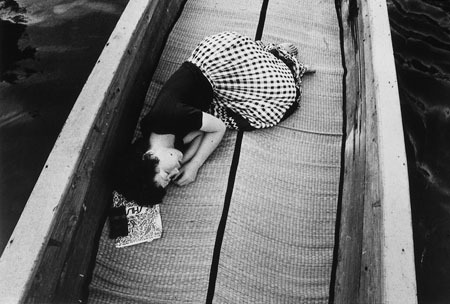Depuis
mon enfance, la fascination envers l’architecture et les grandes villes a
toujours resonné profondément dans mon cœur. La carte vue à vol d’oiseau, le dessin en perspective et le plan
de masse dans les livres de mon père, urbaniste, a provoqué la curiosité de ce
petit garcon que j’étais. J’ai souvent suivi ma mère pour visiter l’appartement
témoin, me demandant comment les lignes du plan avaient été effectivement réalisées
en structures physiques et imaginant ce que ce serait d’y vivre. Comme j’ai
grandi à Séoul, la plus grande métropole coréenne, j’aimais aussi me promener à
travers le centre-ville, entendre les bruits apparemment “chaotiques” mais énergiques
des heures de pointe, et surtout, regarder longuement les gratte-ciels.
Je
me demande et m’interroge chaque fois que je “capture” d’impressionnants paysages
urbains qui frappe mes yeux – que ce soit un bâtiment splendide ou une oeuvre
abstraite d’art plastique placée devant une entrée de métro. “Qu’est-ce que l’architecture?”
“Quelles pensées les architectes ont eu lors de la conception de ce bâtiment?”
L’architecture, c’est peut-être créer et améliorer notre vie, plus que la simple
construction de structures. L’architecture est évidemment une discipline
établie et tangible, mais son interdisciplinarité avec d’autres études – par
exemple, l’art visuel, la géographie et l’histoire – est si profonde que l’architecure
touche presque tous les aspects de notre vie. En tant que personne intéressée à
diverse matières, y compris l’art, la science sociale, la science naturelle et aussi
l’architecture elle-même en général, je suis prêt à me plonger dans le domaine
de l’architecture pour de bon.
Il
me semble que la France est un très bon pays pour étudier l’architecture, non
seulement parce qu’elle est traditionellement renommée pour ses architectes et
artistes mais aussi parce qu’à l’école d’architecture en France, l’éducation offerte
pour chaque étudiant est très bien structurée et équilibrée, pas extrèmement dirigée
vers un seul côté. De plus, la tradition et la modernité, tous deux existent en
France. Même si elle a une très longue histoire, la France n’est pas un pays tourné
vers le passé mais plutôt un lieu plein d’évolution et de changement. Donc, je
peux apprendre comment réconcilier l’innovation architecturale moderne avec la
tradition, un enjeu qu’architectes et urbanistes s’efforcent de résoudre
partout dans le monde. Et parmi les vingt écoles présentes, je suis
particulièrement attiré par l’ENSA de Paris La Villette, à cause de sa
diversité de cours offerts et son accentuation sur la relation entre l’architecture,
l’urbanisme et la culture. Je pense qu’à Paris, l’une des plus importantes
villes mondiales, je serai capable d’observer, de voir actuellement ce que j’apprends
à l’école et de comprendre comment cette ville est devenue un des cœurs architecturaux de l’Europe.
-----------------------------------------------------------------------------------------------------------
Depuis
mon enfance, la fascination envers l’architecture et les grandes villes a
toujours resonné profondément dans mon cœur. La carte vue à vol d’oiseau, le dessin en perspective et le plan
de masse dans les livres de mon père, urbaniste, a provoqué la curiosité de ce
petit garcon que j’étais. J’ai souvent suivi ma mère pour visiter l’appartement
témoin, me demandant comment les lignes du plan avaient été effectivement réalisées
en structures physiques et imaginant ce que ce serait d’y vivre. Comme j’ai
grandi à Séoul, la plus grande métropole coréenne, j’aimais aussi me promener à
travers le centre-ville, entendre les bruits apparemment “chaotiques” mais énergiques
des heures de pointe, et surtout, regarder longuement les gratte-ciels.
Je
me demande et m’interroge chaque fois que je “capture” d’impressionnants
paysages urbains qui frappe mes yeux – que ce soit un bâtiment splendide ou une
oeuvre abstraite d’art plastique placée devant une entrée de métro. “Qu’est-ce
que l’architecture?” “Quelles pensées les architectes ont eu lors de la
conception de ce bâtiment?” L’architecture, c’est peut-être créer et améliorer
notre vie, plus que la simple construction de structures. L’architecture est évidemment
une discipline établie et tangible, mais son interdisciplinarité avec d’autres études
– par exemple, l’art visuel, la géographie et l’histoire – est si profonde que
l’architecure touche presque tous les aspects de notre vie. En tant que
personne intéressée à diverse matières, y compris l’art, la science sociale, la
science naturelle et aussi l’architecture elle-même en général, je suis prêt à
me plonger dans le domaine de l’architecture pour de bon.
Il
me semble que la France est un très bon pays pour étudier l’architecture, non
seulement parce qu’elle est traditionellement renommée pour ses architectes et
artistes mais aussi parce qu’à l’école d’architecture en France, l’éducation offerte
pour chaque étudiant est très bien structurée et équilibrée, pas extrèmement
dirigée vers un seul côté. De plus, la tradition et la modernité, tous deux
existent en France. Même si elle a une très longue histoire, la France n’est
pas un pays tourné vers le passé mais plutôt un lieu plein d’évolution et de
changement. Donc, je peux apprendre comment réconcilier l’innovation
architecturale moderne avec la tradition, un enjeu qu’architectes et urbanistes
s’efforcent de résoudre partout dans le monde. Et parmi
les vingt écoles présentes, je suis particulièrement attiré par l’ENSA-Marseille
à cause de son unique accentuation sur l’environnement côtier et méditerranéen
et son cours sur la construction parasismique qui me permettrait de concevoir
une structure non seulement visuellement agréable mais aussi plus sécuritaire. Comme
beaucoup de grandes villes mondiales se situent au bord de la mer et comme il y
a une grande nécessité, dans certaines regions, de prévenir les risques
possibles par séisme, je pense que l’ENSA-Marseille m’offrira un grand avantage
pour devenir architecte.








